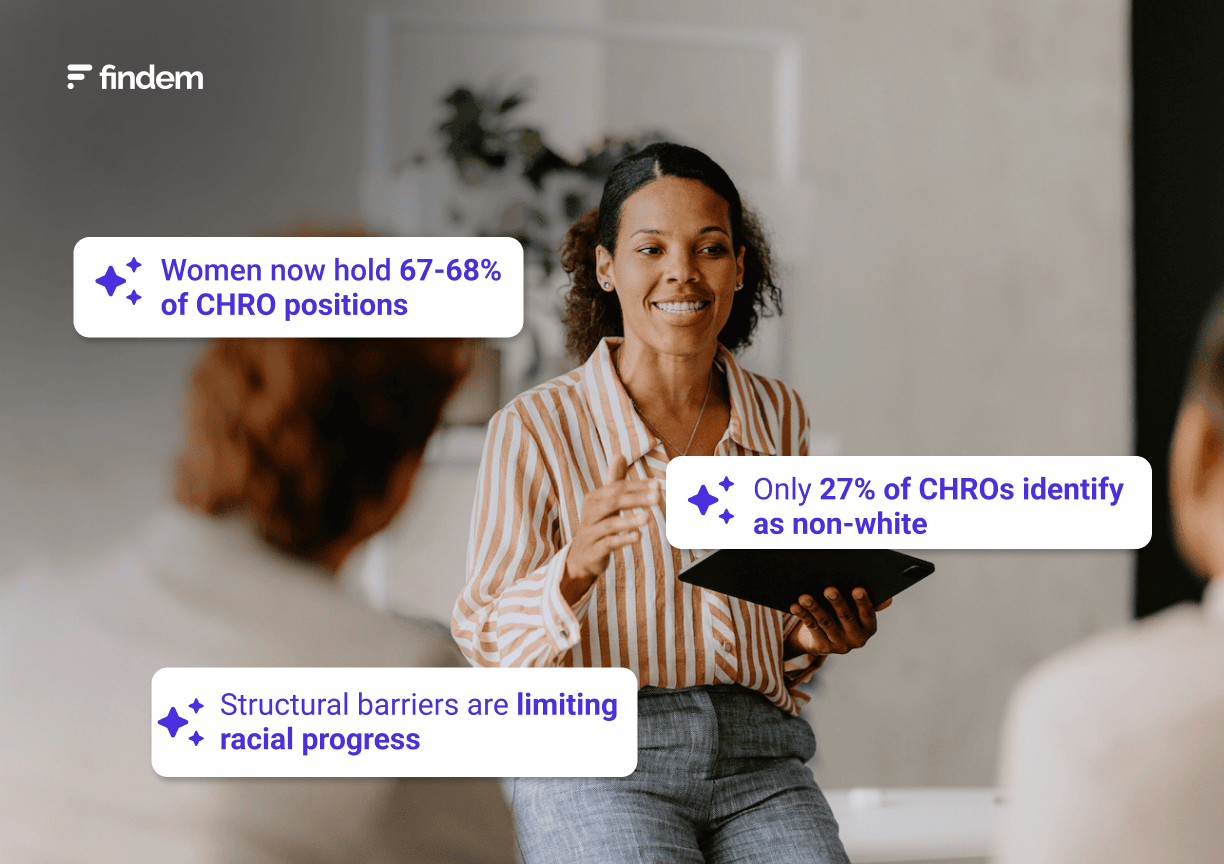.svg)
3 tips for building a diverse, equitable, and inclusive workforce in 2021
.svg)

Companies have long struggled to meet their diversity, equity and inclusion (DE&I) goals even before the COVID-19 pandemic. But now, the silver lining is that location is no longer a limiting factor. With the vast number of employees now working remotely, companies can expand their talent pool beyond their usual geographic boundaries to find the best employees, resulting in a more diverse, well-rounded and competitive workforce. The key to tapping into this new, massive talent pool is people data – data that can tell you who is the best hire in your current environment.
This was one of the central themes of our recent webinar; “How to build a successful DE&I strategy using the right data,” featuring the insights from Barbara Massa, executive vice president and chief of business operations at FireEye, as well as Findem CEO Hari Kolam.
Together, they explored how companies can harness the power of people data to achieve their DE&I goals in three distinct steps create a plan, build a diverse pipeline and foster a culture of belonging.
1) Create a plan
A successful plan starts with getting buy-in from the leadership team about the positive business impacts of DE&I and formalizing processes around it.
“DE&I is at the nexus of what I do, and it’s important for the executive leadership team,” says Massa. “At the end of the day, it’s about people. Products and services don’t get delivered on their own.”
It’s no secret that businesses that have embraced diversity are more profitable and competitive. Just look at the latest McKinsey study that shows companies with more ethnic and cultural diversity outperform those in the fourth quartile by 36%. Those are numbers that should make every business pay attention to the issue, if they haven’t already.
This makes sense when you consider that, with diversity, comes varying backgrounds, experiences and approaches. When you bring diverse employees together, it leads to more creative thinking and multiple angles to approach problems, ultimately paying off in the type of innovation that breeds business success.
DE&I plans are best set and executed upon when they’re built on data. It’s important to collect and analyze real data from your own workforce, as well as from your industry and competitors, to see where you stand and how you stack up. By conducting an audit of this sort, HR professionals can see the talent-hiring bias inherent in their own company and determine realistic DE&I targets that will improve workforce performance and competitiveness.
The focus has to be both on the present and the future, notes Kolam. “Tracking employee and candidate data is often an afterthought when trying to build more diverse teams.” However, he explains, it’s crucial that DE&I plans start with transparency about the current state of the organization — and that “data tracking should extend not just to gender and race, but other factors as well, such as age, religion, disability and military service.’’
When you have that data, you can start mapping out your goals and truly work toward a diverse and inclusive culture.
Successful DE&I plans involve:
- Starting with executive alignment
- Mining data from your HR systems to learn what your current workforce really looks like from a diversity perspective, and inform where your company needs to go from there
- Finding out how your company’s DE&I goals and accomplishments fare against competitors
- Setting goals for your diverse talent pipeline
- Committing to building an inclusive culture
- Measuring your company’s performance in meeting DE&I goals from the start to get benchmarks, and then regularly conducting audits to measure against them
2) Build a diverse talent pipeline
Meeting DE&I goals hinges on your success in hiring diverse candidates who thrive in your organization. That’s why having a pipeline that covers people of every demographic is critical, says Massa. “It’s a journey, a marathon, really. It takes time to build a pipeline of diverse candidates.”
Adds Massa, “Because human beings are involved in hiring, they have an inherent bias. Generally, people are not malicious — they want to do the right thing. But, study after study shows that our networks look like ourselves. The challenge is to find and create opportunities from talent pools that we never knew existed.”
In today’s remote working environment, it’s suddenly easier to connect to underserved populations because location is less of a concern. She suggests tapping into talent pools outside of top universities. Look to regional and community colleges, their professional alumni networks, diversity-focused professional organizations, and similar resources to get connected to talent that might otherwise go under the radar.
It is vital to monitor the talent pipeline to ensure you’re nurturing diversity right from the start of the candidate search. This can be done by triangulating Census, educational and other data to identify diverse candidates and chart a path to recruit them. Or, you can tap into a technology solution, such as Findem, that does this work for you.
Examples of other ways to reach beyond the normal networks are to train recruiters and managers to write unbiased job postings, and to automate the talent search as much as possible in a way that pinpoints qualified diverse candidates.
3) Foster a culture of belonging
Of course, finding and attracting top, diverse candidates won’t help if they find an unwelcoming culture when they are hired. Before you undertake your diversity hiring initiative, consider auditing your team to assess if work needs to be done to ensure new-hires are embraced, happy and will stick around for the long term. One way to go about this is to measure your employees’ views on the workplace culture — whether they’re remote or on-site. Online surveys, remote focus groups and virtual suggestion boxes are all good ways to get your employees’ perspectives.
Next, provide manager training and employee awareness programs that reinforce the company’s commitment to its DE&I goals and address any issues that surfaced when you conducted your employee culture audit. “There’s a ton of resources out there,” says Massa. “You don’t have to go it alone.”
Connecting diverse employees to each other can also improve the culture. Employee Resource Groups (ERGs) are a way to connect new employees with fellow workers of similar backgrounds, giving them an extra hand to navigate the company culture and to find their place within the organization.
“A feeling of belonging is so important,” Massa says. “Employees need to feel safe to represent themselves authentically.”
Finally, tracking retention and promotion experiences across all employee demographics is critical, says Massa. “These metrics reflect company culture. Data is the great illuminator. It creates insights for people leaders to act on, not just share in PowerPoints.”
It’s especially useful to look at the intersectionality of demographics. “You can’t focus just on racial or gender diversity alone,” she notes. “Neither one can be left at the wayside. Use technology to understand the data and the causality. Few organizations have an army of analytics folks to figure this out.”
DE&I…and data
In the end, data makes creating and implementing a successful DE&I plan possible, says Kolam.
“Findem was founded on the belief that people decisions shouldn’t be made from fractured data, disjointed tools and guesswork. Without unbiased, accurate people metrics for potential and current employees, a successful plan is not possible.”
“It’s important to talk about DE&I and data regularly at the top-most level of the organization,” adds Massa. “This signals to the entire company that this is not just important at the grassroots level, but that it’s also important from a culture perspective. Regularly sharing words and actions is what matters.”
Want to learn more about the impact data can have on your DE&I strategy? Watch the complete webinar here.










